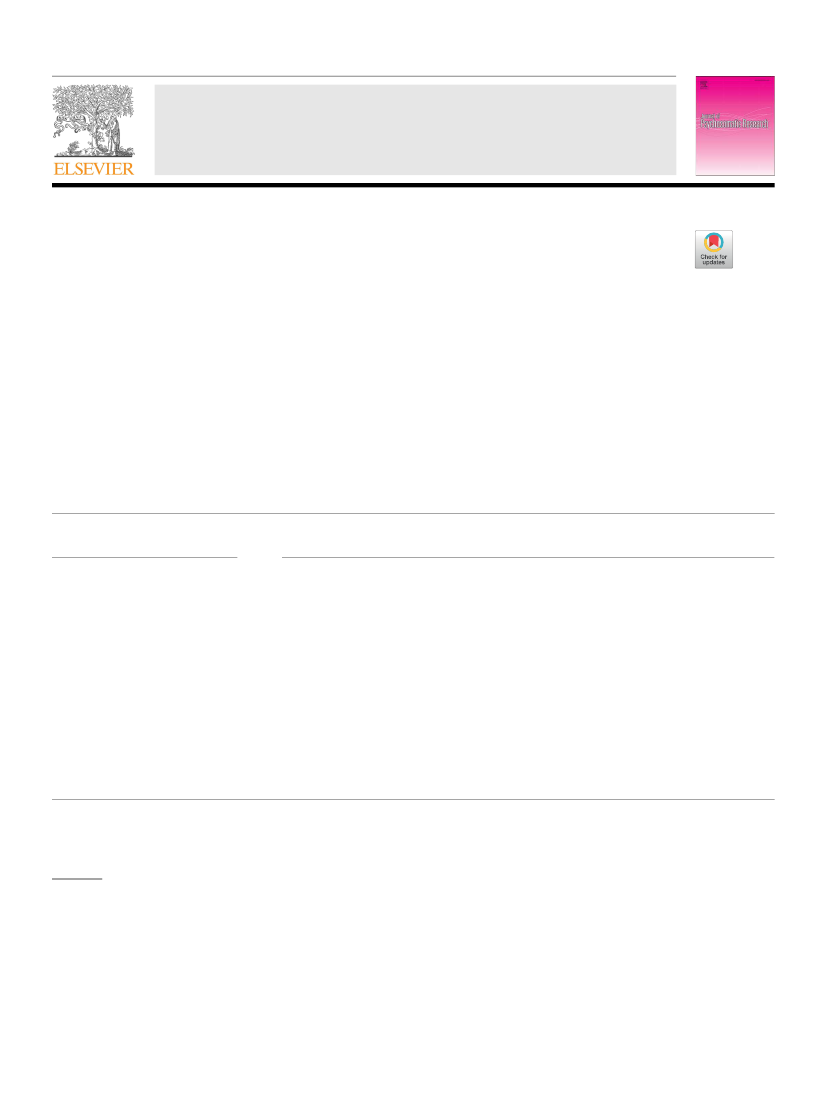
Journal of Psychosomatic Research 128 (2020) 109867
Contents lists available at
ScienceDirect
Journal of Psychosomatic Research
journal homepage:
www.elsevier.com/locate/jpsychores
Effort-reward imbalance at work and risk of type 2 diabetes in a national
sample of 50,552 workers in Denmark: A prospective study linking survey
and register data
☆
Mads Nordentoft
a,b,
, Naja H. Rod
b
, Jens Peter Bonde
c
, Jakob B. Bjorner
a,d,e
, Ida E.H. Madsen
a
,
Line R.M. Pedersen
a
, Bryan Cleal
f
, Linda L. Magnusson Hanson
g
, Mette A. Nexo
f
, Jaana Pentti
h,i
,
Sari Stenholm
h
, Tom Sterud
j
, Jussi Vahtera
h
, Reiner Rugulies
a,b,k
⁎
a
T
National Research Centre for the Working Environment, Copenhagen, Denmark
Section of Epidemiology, Department of Public Health, University of Copenhagen, Copenhagen, Denmark
c
Department of Occupational and Environmental Medicine, Bispebjerg-Frederiksberg Hospital, Copenhagen, Denmark
d
Optum Patient Insights, Lincoln, RI, USA
e
Section of Social Medicine, Department of Public Health, University of Copenhagen, Copenhagen, Denmark
f
Steno Diabetes Center Copenhagen, Gentofte, Denmark
g
Stress Research Institute, Stockholm University, Stockholm, Sweden
h
Department of Public Health, University of Turku and Turku University Hospital, Turku, Finland
i
Clinicum, Faculty of Medicine, University of Helsinki, Helsinki, Finland
j
The National Institute of Occupational Health, Oslo, Norway
k
Department of Psychology, University of Copenhagen, Copenhagen, Denmark
b
A R TICL E INFO
Keywords:
Diabetes mellitus
Epidemiology
Occupation
Population-based
Psychosocial work factors
Stress
A BSTR A CT
Objective:
To examine the prospective relation between effort-reward imbalance at work and risk of type 2
diabetes.
Methods:
We included 50,552 individuals from a national survey of the working population in Denmark, aged
30–64 years and diabetes-free at baseline. Effort-reward imbalance was defined, in accordance with the litera-
ture, as a mismatch between high efforts at work (e.g. high work pace, time pressure), and low rewards received
in return (e.g. low recognition, job insecurity) and assessed as a continuous and a categorical variable. Incident
type 2 diabetes was identified in national health registers. Using Cox regression we calculated hazard ratios (HR)
and 95% confidence intervals (95% CI) for estimating the association between effort-reward imbalance at
baseline and risk of onset of type 2 diabetes during follow-up, adjusted for sex, age, socioeconomic status,
cohabitation, children at home, migration background, survey year and sample method.
Results:
During 136,239 person-years of follow-up (mean = 2.7 years) we identified 347 type 2 diabetes cases
(25.5 cases per 10,000 person-years). For each one standard deviation increase of the effort-reward imbalance
score at baseline, the fully adjusted risk of type 2 diabetes during follow-up increased by 9% (HR: 1.09, 95% CI:
0.98–1.21). When we used effort-reward imbalance as a dichotomous variable, exposure to effort-reward im-
balance was associated with an increased risk of type 2 diabetes with a HR of 1.27 (95% CI: 1.02–1.58).
Conclusion:
The results of this nationwide study of the Danish workforce suggest that effort-reward imbalance at
work may be a risk factor for type 2 diabetes.
Abbreviations:
ANOVA, analysis of variance; ATC, anatomical therapeutic chemical; BMI, body mass index; CI, confidence interval; ERI, effort-reward imbalance;
HPA, hypothalamus-pituitary-adrenal; HR, hazard ratio; ICD-10, international classification of diseases and related health problems version 10; NRCWE, National
Research Centre for the Working Environment; PCOS, polycystic ovarian syndrome; SES, socioeconomic status; WEHD, Work Environment and Health in Denmark
2012–2020.
☆
The study was conducted at the National Research Centre for the Working Environment, Copenhagen, Denmark.
⁎
Corresponding author at: National Research Centre for the Working Environment, Lerso Parkallé 105, DK-2100 Copenhagen, Denmark.
E-mail address:
(M. Nordentoft).
https://doi.org/10.1016/j.jpsychores.2019.109867
Received 30 August 2019; Received in revised form 31 October 2019; Accepted 31 October 2019
0022-3999/ © 2019 The Authors. Published by Elsevier Inc. This is an open access article under the CC BY-NC-ND license
(http://creativecommons.org/licenses/BY-NC-ND/4.0/).